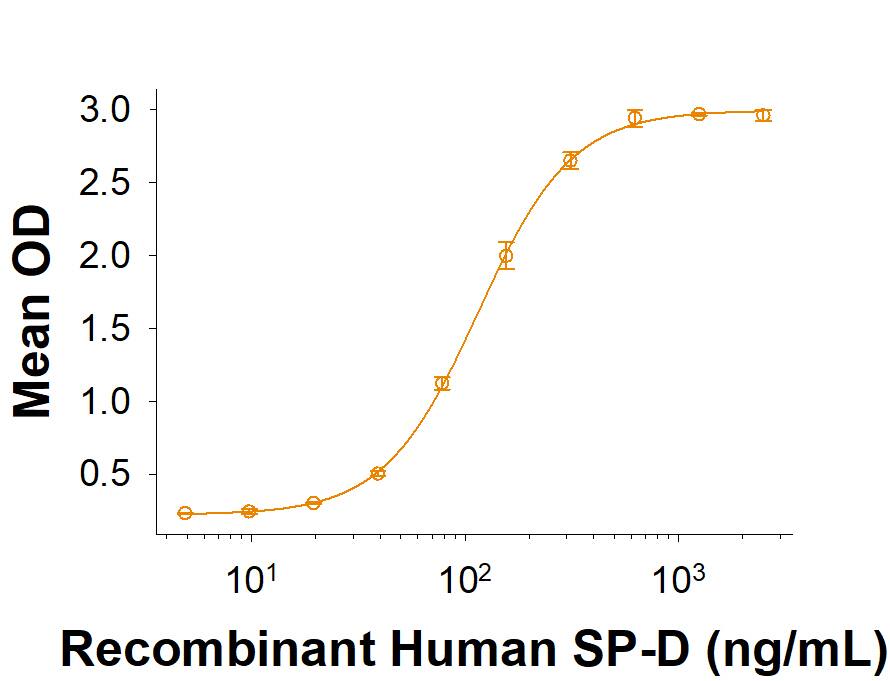Recombinant Mouse SIRP beta 1B Fc Chimera Protein, CF
R&D Systems, part of Bio-Techne | Catalog # 10335-SB

Key Product Details
Source
Accession #
Structure / Form
Conjugate
Applications
Product Specifications
Source
| Mouse SIRP beta 1B (Met28-Gly360) Accession # NP_001166931.1 |
IEGRMDP | Mouse IgG2a (Glu98-Lys330) |
| N-terminus | C-terminus |
Purity
Endotoxin Level
N-terminal Sequence Analysis
Met28 and Arg29
Predicted Molecular Mass
SDS-PAGE
Activity
When Recombinant Mouse SIRP beta 1B Fc Chimera (Catalog # 10335-SB) is immobilized at 1 µg/mL (100 µL/well), Recombinant Human SP-D (Catalog # 1920-SP) binds with an ED50 of 40-320 ng/mL.
Scientific Data Images for Recombinant Mouse SIRP beta 1B Fc Chimera Protein, CF
Recombinant Mouse SIRP beta 1B Fc Chimera Protein Binding Activity
When Recombinant Mouse SIRP beta 1B Fc Chimera (Catalog # 10335-SB) is immobilized at 1 µg/mL (100 µL/well), Recombinant Human SP-D (Catalog # 1920-SP) binds with an ED50 of 40-320 ng/mL.Formulation, Preparation and Storage
10335-SB
| Formulation | Lyophilized from a 0.2 μm filtered solution in PBS. |
| Reconstitution | Reconstitute at 500 μg/mL in PBS. |
| Shipping | The product is shipped with polar packs. Upon receipt, store it immediately at the temperature recommended below. |
| Stability & Storage | Use a manual defrost freezer and avoid repeated freeze-thaw cycles.
|
Background: SIRP beta 1B
Signal-regulatory protein beta 1b (SIRP beta 1b), or CD172b, is a disulfide-linked type I membrane glycoprotein belonging to the SIRP/SHPS/CD172 family of the immunoglobulin (Ig) superfamily. The three SIRP family members are paired receptors that have a conserved extracellular domain (ECD) but differing C-terminal domains and functions (1). The ECD of SIRP beta 1b contains one V-set Ig and two C1-set Ig domains. The mature ECD of mouse SIRP beta 1b shares 57% amino acid sequence identity with human SIRP beta 1. Proteins in the SIRP family are typically expressed in cells of monocyte, macrophage or dendritic lineages and positively charged residues within the transmembrane domain mediate interactions with DAP12 proteins which contain immunoreceptor tyrosine-based activation motifs (ITAMs) (3, 4). SIRP beta 1 has a relatively short cytoplasmic region and lacks the signaling motifs for association with phosphatases. However, formation of the SIRP beta 1/DAP12 complex in myeloid cells induces tyrosine phosphorylation, mitogen-activated protein kinase activation, and cellular activation (5, 6). Engagement of SIRP beta 1 by specific monoclonal antibodies promoted Fc gamma receptor-dependent or - independent phagocytosis in mouse peritoneal macrophages (7). Surfactant protein D (Sp-D) has been shown to bind SIRP alpha and SIRP beta 1 in a calcium-dependent and sugar-specific manner on a distinct binding site from CD47 (8). Although the SIRP beta 1 extracellular regions share a high degree of homology with the SIRP alpha, SIRP beta 1 has been shown not to bind CD47 (9).
References
- vanBeek, E.M. et al. (2005) J. Immunol. 175:7781.
- van den Berg, T. et al. (2008) Trends in Immunology 29:203.
- Liu, Y. et al. (2005) Journal of Biological Chemistry 280:36132.
- Matozaki, T. et al. (2009) Trends in Cell Biology 19:72.
- Dietrich, J. et al. (2000) J. Immunol. 164:9.
- Brook, G. et al. (2004) J. Immunol. 173:2562.
- Hayashi, A. et al. (2004) J. Biol. Chem. 279:29450.
- Fournier B. et al. (2012) J. Biol. Chem. 287:19386.
- Seiffert M. et al. (2001) Blood 97:2741.
Long Name
Entrez Gene IDs
Gene Symbol
UniProt
Additional SIRP beta 1B Products
Product Documents for Recombinant Mouse SIRP beta 1B Fc Chimera Protein, CF
Product Specific Notices for Recombinant Mouse SIRP beta 1B Fc Chimera Protein, CF
For research use only
